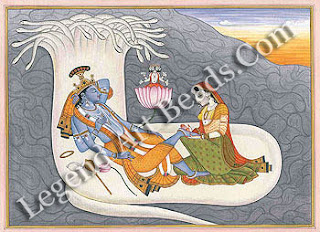 Vishnu's Slumber
Vishnu's Slumber
After
pralaya, there was a lull.
Nothing
stirred. Vishnu rested in perfect tranquility on the endless coils of
Ananta-Sesha, the serpent of Time, awaiting the reawakening of the world.
Around
him, stretching into infinity stood the still primeval waters. In them lay
dissolved without form or identity all that once existed. This was yoga-nidra,
the cosmic slumber.
Birth of Brahma
Vishnu
opened his eyes, setting the stage for creation. The seed of life present in
his body emerged from his navel as a thousand-petalled lotus. On it sat Brahma,
the creator.
The
creator looked in the four cardinal directions: he found nothing he could
create the new world with.
He
closed his eyes and pondered over the problem.
Cosmic Being
"Mould
the three worlds out of Vishnu's creative energy, his Maya," a voice
whispered in Brahma's ear. The creator opened his eyes to a splendid vision the
breathtaking cosmic form of Vishnu, his vishvarupa:
The lord's
body encompassed the whole universe.
Within
him was present the one cosmic soul; the two genders; the three strides of
time; the four books of knowledge; the five elements; the six philosophies; the
seven sheaths of the body; the eight directions; the nine emotions; the ten
vital breaths; the twelve zodiacs; the fourteen planes of existence; the
twenty-seven lunar asterisms; the thirty-three gods; the sixty-four arts; the
seventy-two vocations; the hundred and eight divine spirits.
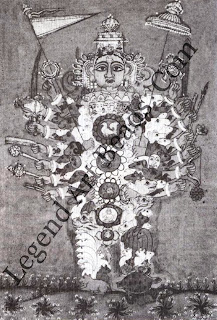 The
celestial bodies made up his eyes; the oceans were contained in his stomach;
the mountains were his bones the rivers flowed through his veins; the trees
stood as his body-hair. His upper body was the sky; his lower body, the abyss.
The
celestial bodies made up his eyes; the oceans were contained in his stomach;
the mountains were his bones the rivers flowed through his veins; the trees
stood as his body-hair. His upper body was the sky; his lower body, the abyss.
From his right nostril he exhaled life; from
the left he inhaled death.
He was
the cosmic substance, prakriti that gives form to existence; he was also the
cosmic spirit, purusha that gives life meaning.
He was
infinite Space and eternal Time. He was everything that was, is and will be.
He was
the Virat-purusha, the entity that is the cosmos.
Sacrifice of Vishnu
Brahma
said, "Without a sacrifice, yagna, nothing can be obtained. To create a
new world, what shall I sacrifice?"
"Sacrifice me." said Vishnu.
"What shall I use as the sacrificial knife, the
sacrificial altar and the sacrificial post?"
"Use me," said Vishnu.
"Where do I find
the sacred fire and the sacred chants?"
"In me,"
said Vishnu.
"Who will be the presiding deity?"
"It will be me.
I will also be the offering and the reward," said Vishnu.
Vishnu, the
embodiment of every aspect of the cosmic sacrifice, became known as
Yagna-purusha.
A Quarter of Vishnu
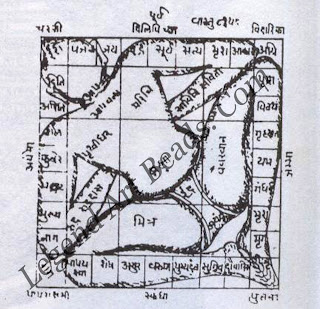 Brahma
divided Vishnu into four parts. So vast was Vishnu that from just one quarter
of his being Brahma could create the whole world and everything in it,
including the gods and the demons.
Brahma
divided Vishnu into four parts. So vast was Vishnu that from just one quarter
of his being Brahma could create the whole world and everything in it,
including the gods and the demons.
Vishnu
was Vastu-purusha, the lord of Space, from which Brahma moulded the eight
directions of the cosmic dwelling, its roof and its floor. Vishnu was
Yuga-purusha, the lord of Time, whom Brahma divided into the four ages Krita,
Treta, Dvapara, Kali that make up one kalpa, the lifespan of a world.
Overwhelmed
by the sheer magnificence of Vishnu, Brahma saluted him, "You are Bhagavan,
the totality of the cosmos. Everything in this world has come from you."
Churning of the Cosmic Ocean
First came the gods and the demons. As soon as
they were created, they surveyed the cosmos it was bereft of vitality.
"Where is everything?" they wondered.
Vishnu said, "All that you seek lies dissolved in the
primeval waters. Churn it out."
"But what do we use as a churning spindle?" they
asked.
“Use Mount Meru, the axis of Space."
"And for the
churning rope?"
"Use Ananta-Sesha, the serpent of Time."
Emusha, the Divine Boar
Mount
Meru lay submerged beneath the primeval waters. Neither the gods nor the demons
could pull it out.
So Vishnu
took the form of Emusha, the celestial boar his flanks stretched across the
horizon, his snout reached into the heavens. Emusha plunged into the waters,
ploughed up Meru with his mighty tusks and brought it to the surface.
Vishnu
then wound Ananta-Sesha round the celestial mount to create the cosmic churn.
Kurma, the Divine Turtle
Turning
into Kurma, a gigantic turtle, Vishnu supported the cosmic churn on his back.
So vast
was Kurma that his upper shell made up the vault of the heavens and held the
sky; his lower shell formed the abyss and contained the sea. His feet rested
upon the four cardinal directions.
The
gods and demons saluted this cosmic turtle. "You are Akupara, the
celestial foundation of the universe."
Kurma's Strength
The
gods held Sesha's tail, the demons grabbed his neck and they began churning the
cosmic waters. But no matter how hard they strained, Mount Meru would not
whirl. "Hel0 us, Kurma," they cried, "Give us some of your
abundant strength." The divine turtle let his radiance invigorate the gods
and the demons. Soon they were churning the ocean with ease.
The
mountain twisted and turned, the ocean frothed and fumed. The new world would
soon emerge.
Kalakuta the Deadly Poison
After a
thousand years of churning there rose from the ocean Kalakuta, the accumulated impurities
of the old world. So terrible was this poison that it scorched Vishnu's skin,
making him Hari, the tawny-one.
On
Vishnu's request, Shiva collected the lethal fluid and drank it as if it was
sweet wine.
The
gods and demons began churning the waters free of all impurities with renewed
vigour, convinced that success was close at hand.
Refreshing Rain
As the
churning became intense, the rocks on the mountain slopes crashed into each
other, spitting fire that set ablaze the trees atop Meru. Smoke filled the air choking
the gods and the demons. Eyes turned red, throats became dry.
"Help us, Kurma," they cried.
The divine turtle flapped its flippers and splashed water
all around, putting out the fire, clearing the air, refreshing everyone.
Rhythm of Life
As the
churning continued, the formless, limitless mass within the cosmic waters began
to take wonderful shape.
First came the sun, the moon and the pole star.
Vishnu placed the pole star above Mount
Meru; the sun and moon danced round it. This gave rise to the cyclical rhythm
of seasons, ritu. As spring turned to summer and summer to winter, plants began
to flower and fruit while animals began to eat, mate, migrate and hibernate.
Vishnu, the pivot of this wheel of life, came to be known as
Chakrapani.
Five Elements
Then
came the elements earth, fire, wind and water. But no sooner were they churned
up than they began slipping away in different directions.
Vishnu
stretched out his four hands and reined in the four escaping elements. Fire became
his discus, water his lotus, wind his conch and earth his mace. He became ether
and permeated every corner of space weaving all things into the cosmic fabric
like the string in a necklace of beads.
With
that, Vishnu came to be known as the lord of cohesion, Vaikuntha,
he-who-prevents-disintegration.
Lakshmi and Her Gifts
As the
churning continued, there emerged from the cosmic waters its most precious
gift: Lakshmi, the goddess of fortune and splendour, bestower of power,
prosperity and pleasure.
The
goddess brought with her many gifts: Kamadhenu, the life-sustaining cow;
Kalpavriksha, the wish-fulfilling tree; Kaustubha-Parasmani, the most radiant
of jewels; Rambha, the celestial courtesan; Sura, the goddess of wine;
Airavata,
the six-tusked, the white-skinned elephant; Ucchaishrava, the seven-headed
flying horse; Sharanga, the perfect bow; and Panchajanya, the divine conch.
The Divine Physician
With
Lakshmi came Dhanvantari, the divine physician.
Dhanvantari,
the foe of disease, death and decay, contained the spirit of Vishnu. He brought
with him the science of health and healing known as Ayurveda, a bag of herbs, a
leech to suck out toxins, a knife to cut out tumours, a pestle and mortar to
make medicinal pastes and potions. In his jewelled hands he carried a pot of
amrita the elixir of immortality.
Theft of Amrita
The
demons grabbed the vessel from the hands of Dhanvantari and ran away.
Angered
by the theft, Vishnu decided to teach the demons a lesson. He approached them
taking the form of Mohini, the enchantress, a voluptuous damsel with an
alluring smile and enticing eyes.
"May I serve the
amrita?" asked Mohini.
"You may," said the demons, eager to please.
Mohini took the pot and began serving the nectar. The demons, bewitched by her
beauty, failed to notice that she was pouring the divine drink only down the
throats of the gods.
Rahu and Ketu
Rahu,
suspicious of Mohini, sat amidst the gods disguised as one of them. The sun and
the moon recognised the demon and alerted Vishnu. By then, however, some amrita
had been poured into Rahu's mouth.
Vishnu
immediately hurled his discus, the Sudarshan-chakra, and severed Rahu's neck
preventing the nectar from entering his body.
Deprived
of his body, Rahu swore to destroy his betrayers. He became the demon of
eclipse that gnaws the bright faces of the sun and the moon from time to time.
His
headless body became the astral entity known as Ketu.
Vishnu Defeats the Asuras
The demons
realised Vishnu did not intend to give them even a drop of nectar. They were
incensed, but it was too late. Amrita had transformed the gods into powerful,
luminous devas.
The
demons, deprived of the drink, remained dark and gloomy Asuras. Feeling betrayed,
they attacked the gods.
Vishnu
picked up Sharanga, the bow that had emerged from the cosmic sea, and shot
deadly missiles at the Asuras, helping the devas push them into the deepest
recesses of the cosmos, the Patala.
As the
gods celebrated their victory, Vishnu blew the divine conch Panchajanya and
placed the radiant jewel Kaustubha on his crown.
Lakshmi Marries Vishnu
Indra,
eldest of the gods, invited Lakshmi to be his queen. "No. Only Vishnu is
worthy of me," said the goddess. "Did he not, as Matsya, save the
seed of life? Did he not, as Kurma, help churn me out of the cosmic sea? He is
canny enough to be Mohini, the enchantress, and trick the demons; capable
enough, as the bowman Sharangin, to lead the gods. He will protect me, love and
respect me."
Lakshmi
placed the garland of victory, Vaijayanti, around Vishnu's neck and made him
her beloved consort, Vallabha.
The
gods cheered this union.
Brahma
blessed it.
Hamsa, the Divine Swan
Enchanted
by the splendour of the three worlds, Brahma sprouted four heads and began
admiring his creation from every angle. "Contain your pride," said
Vishnu. "The universe you have moulded out of my Maya is not permanent. It
exists today, but will be gone tomorrow."
"What is the
purpose of such transitory existence?" asked the creator.
"Samsara exists to help man explore and experience the
divine," replied Vishnu.
Vishnu then took the form of Hamsa, the swan, and began
swimming in a river. The river did not restrain him in any way. He could fly
away whenever he wished to, with not one drop of water burdening his wings.
Said Hamsa, "I enjoy the river; it helps me live. But I
can fly only when I detach myself from the water. In the same way, he who seeks
divinity must live in samsara without being attached to its flow."
Thus did Vishnu explain to Brahma the essence of life's
mystery. The swan, the symbol of enlightenment and absolute freedom, became
Brahma's mount.
Writer
– Devdutt Pattanaik
 Vishnu's Slumber
Vishnu's Slumber  The
celestial bodies made up his eyes; the oceans were contained in his stomach;
the mountains were his bones the rivers flowed through his veins; the trees
stood as his body-hair. His upper body was the sky; his lower body, the abyss.
The
celestial bodies made up his eyes; the oceans were contained in his stomach;
the mountains were his bones the rivers flowed through his veins; the trees
stood as his body-hair. His upper body was the sky; his lower body, the abyss. Brahma
divided Vishnu into four parts. So vast was Vishnu that from just one quarter
of his being Brahma could create the whole world and everything in it,
including the gods and the demons.
Brahma
divided Vishnu into four parts. So vast was Vishnu that from just one quarter
of his being Brahma could create the whole world and everything in it,
including the gods and the demons. 
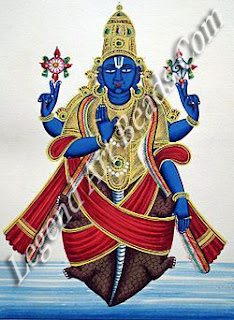
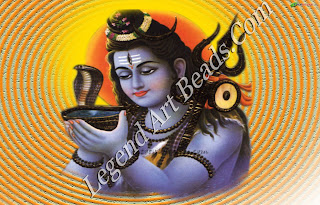
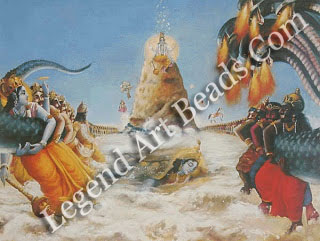
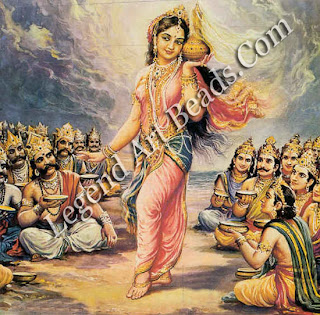
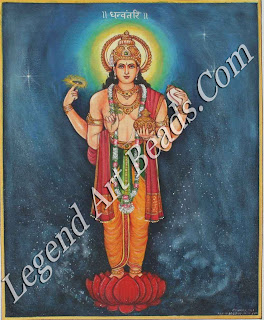
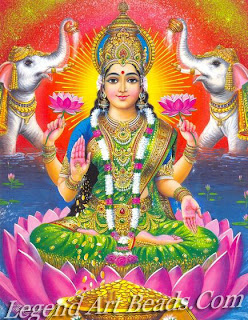
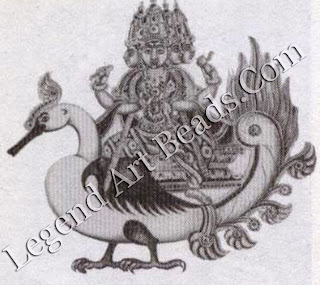










0 Response to "Vishnu Create's the Creator"
Post a Comment